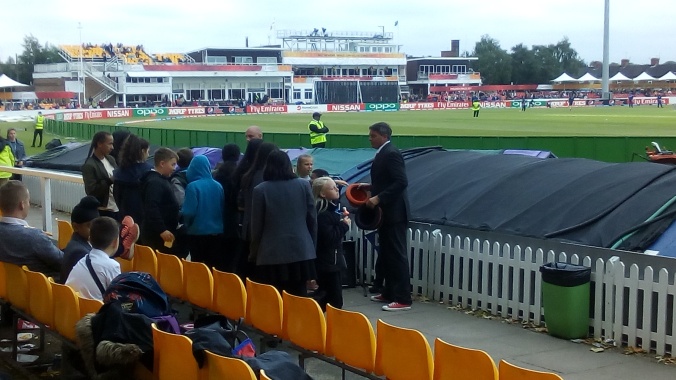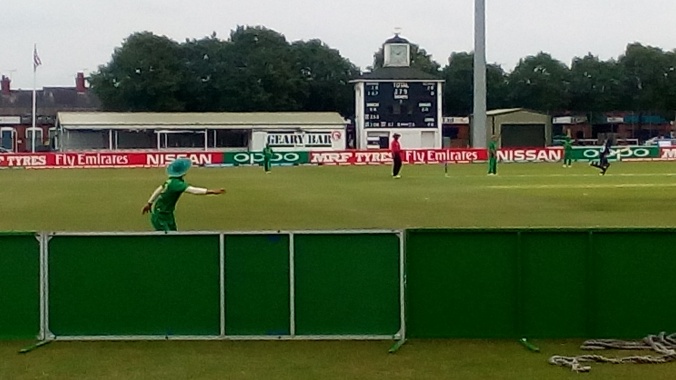England v Pakistan, Australia v Pakistan, India v South Africa, West Indies v Pakistan, Sri Lanka v Pakistan (all Women’s World Cup, Grace Road, 27th June to 15th July 2017)
Leicester’s New Walk Art Gallery and Museum has, in its permanent collection, a painting by Stanley Spencer accompanies it contains the phrase “the girls ecstatic, the old men bewildered or indifferent”. This phrase stuck in my mind, when I visited a few weeks ago, because I thought it might come in handy when describing the crowd for the Women’s World Cup, which has been occupying Grace Road, and much of my attention, for the past three weeks.
In the event, that wasn’t quite how it was, but there are certainly those who have been left baffled by, and indifferent to it, and not all of them old or men. The usual suspects, the Leicestershire members who watch Championship (and often one-day) cricket at Grace Road were, with very few exceptions, conspicuously absent. Where they have been is unclear. There were a happy few (a very few, though not very happy) at the day-night game at Northampton, and, no doubt, some will have made their way to the Sussex game at Arundel. Some will have been biding their time and waiting for the T20 season to begin (though, because of the World Cup, the Foxes’ first four games are all away from home).
Some, though, particularly those who are not interested in T20, will simply have given up on watching live professional cricket altogether. To re-iterate, between the end of the Sussex game on 12th June and the beginning of the Gloucestershire game on 5th September, there is only one non-T20 game involving Leicestershire at Grace Road (the Championship game against Durham beginning 8th August). If what you want to watch is Championship, or even one-day, cricket, and are at all averse to being cold and wet, Membership represents increasingly poor value and, some, I know, have, as I say, simply given it up as a bad job.
That is one reason why the attitude of some goes beyond indifference to active hostility. Another is the perception that the club is more interested in pandering to the ECB and its various visions than in producing a successful Leicestershire team (this season’s woeful results have not helped in this respect). There is, too, a suspicion that the women’s game is, to use a retro term, more hype than substance, that it is being promoted by powerful forces for reasons that have little to do with its intrinsic merits.
In fact, about the only thing about women’s cricket that can be irksome (the matches themselves are usually enjoyable to watch) is the uncritical and breathlessly enthusiastic tone that some commentators feel obliged to adopt when writing about it, rather like a 14-year-old E.W. Swanton reporting on a House Match.
I am inexpert at estimating the size of crowds, but both ‘The Times’ newspaper (and, a more reliable source, Clare in the Meet) informed me that 1,000 tickets had been sold in advance, and 2,000 given away to parties of schoolchildren for my first game, between England and Pakistan. Of the five games I saw, there were, perhaps, 2,000 paying customers for the weekend game between India and South Africa (mostly India supporters), and perhaps 200-300, free or paying, for the other three (the parties of children tend to melt away at going-home-time, leaving a breathless hush in the Meet, and, by the end of the Pakistan-West Indies game, the crowd was in close to single figures).
As to who these paying customers were, they were not noticeably young nor female, nor seemed interested, specifically, in women’s cricket, but pretty much, I imagine, the same types who would turn out to support the mens’ teams of their respective countries.
The general aim seemed to be to create a sort of stadium rock experience, with elements borrowed from the 2012 Olympics. As always with an ECB event, there were a large number of security staff, augmented by “Cricketeers”, whose job, rather like Butlins’ Redcoats, or the Mouseketeers, was to ensure that the crowd had a good time, all of the time.

Inevitably, there was face painting, and a gospel choir.

Grace Road had made some attempt to accommodate a feminine audience, by providing a pop-up prosecco van, and warning against wearing high heels in the Maurice Burrows stand (they must have had problems with this in the past)
Even Wasim Khan (I think it was him, anyway) joined in the fun, by performing a juggling act with hats.

There were all the elements that, I imagine, are familiar to the T20 regulars, but less so to me. Any lull in the action was filled by a randomly chosen burst of music : the only ones I recognised were AC/DC’s Thunderstruck (which went down well with the Australians) and bizarrely, given its lyrical content, Primal Scream’s Rocks ; my daughter, who accompanied me to one game, described the others as Some Random Shit, though I’m not sure whether that was the name of the genre or the artiste.
The music was played to mark any significant event, such as a wicket or a boundary, which were also marked by some contraption that resembled multicoloured ectoplasm leaping into the air from a box. While the schoolchildren were present this was greeted by a noise like 2,000 pocket air raid sirens going off, presumably in response to the music, the ectoplasm and the urgings of the Cricketeers, rather than any understanding of what had happened on the pitch, given that the boundaries had been brought in so far in front of the stand where most of the children were corralled that they would have needed telescopes to see it

In fact, I was struck by how few opportunities there seemed to be, for the children in particular, to get at all close to the players. Usually at Grace Road, because the players have lunch and tea in the Charles Palmer suite, anyone who wants to ask for autographs or take a photograph of themselves with them has plenty of chances to buttonhole them, and even the bigger stars (such as Cook or Broad) are usually happy to comply. During the WWC, the players mostly sat between the usual and the actual boundary in a sort of beach bar arrangement, with benches and parasols, and the security staff strongly discouraged any attempt to make contact with them (the mob eventually managed to descend on India’s regal Captain, Mithali Raj, as she made the short journey back to the dressing room).

One player whom it was possible to observe at close quarters was the South African Marizanne Kapp, who, much to the consternation of the security staff, dashed off the pitch several times through the Fox Bar to the ladies’ lavatories. The South Africans seemed to have taken the odd decision to ban smiling and encourage glaring in their pictures in the (very useful) programme, with the result that they looked like a group of prison warders with some of their more dangerous charges. Kapp, in particular, looked rather as though she was about to be interviewed by Piers Morgan about how it was that she had come to poison five husbands, so it was a relief to find that she is actually perfectly pleasant-looking.
The first match followed the same pattern as the one day game between the same sides at Grace Road last year : England batted first and knocked up a large score, which Pakistan made only a token effort to chase. In fact this was the pattern of the first four of the World Cup games I saw. England, Australia, South Africa and the West Indies made 377-7, 290-8, 273-9 and 285-4 respectively, with Pakistan (India against South Africa) making 107-3 (against a DLS target of 215), 131 all out, 158 all out and 117-3 (against a DLS target of 137).
There have been changes in the women’s game since I saw my first one-day game, which must have been in about 2004, mostly in the direction of increased athleticism. The seam bowling has increased in pace, though not, I’d say, very dramatically. The fielding is more athletic, though unlike the men, they have not taken to the sliding stop and flip back (which now seems obligatory, even when completely unnecessary). There are still a plethora of overthrows and comedy run outs, though this might be because the side I saw the most of were Pakistan, who rather specialised in them.
The biggest change, though, has been the advent of the “power hitter” – the player who can get her foot to the pitch of the ball and hit it back over the bowler’s head. The sides who batted first and won collectively hit 27 sixes, 18 of them by four players : Sciver of England (4), Villani of Australia (4), Lee of South Africa (7) and Dottin of the West Indies (3). The sides who batted second and lost only managed 2. India are a slightly different case, in that their chief power hitters, Mandhana and Kaur, were out cheaply, but Pakistan, a small side, were simply unable to compete. As their Captain, Sana Mir, plaintively admitted after the England game : “We knew that it was impossible for us to chase. We are not so powerful like them, and we have no big hitters”.
The South Africans, a strenuously athletic side, rather rubbed this in, having overpowered India, by warming down on the pitch afterwards, while the Indians had a sit down under their parasols, and Mithali Raj, presumably, finished reading her famous book.
It occurs to me that watching the women’s game now is rather what it must have been like watching the men’s game in the earliest days of the modern era (in the 1870s and 1880s) : predominantly medium pace bowling and spin, well-pitched up, with the batsmen playing off the front foot with a straight bat (though I’m not sure that Nat Sciver would recognise any real sense of kinship with the likes of “Buns” Thornton). The West Indian ‘keeper, Merissa Aguileira, added a further antiquarian touch by fielding without pads, and Sciver headed further back into the past by reviving the “draw”, a stroke that was last in fashion when W.G. Grace was beardless.
During the course of the competition I became quite attached to Pakistan, who were based in Leicester (why not India, whom I would have expected to attract larger crowds, I don’t know). I might have become equally attached to India, who, though a better side, also seemed better suited to the longer forms (now virtually defunct in the women’s game). I remember a young Mithali Raj playing in what must have been one of her earliest Tests at Grace Road. Her style was to play five immaculate forward defensives, followed by an elegant cover drive and a gently strolled single. She is now a very grand personage, who looks as though she ought to be led to the wicket, riding side-saddle on a white Arabian stallion : she can adapt her style a little to the one-day game, but, you feel, actual power-hitting is a little beneath her.
Pakistan had begun their tournament promisingly (in a match I did not see) by losing narrowly to South Africa, and they began quite promisingly against England. They opened, unusually, with two seam bowlers, who restricted England’s scoring in the power play and removed dangerwoman Tammy Beaumont. Perhaps conscious that it was an area that required improvement, they were fielding like tigers (or perhaps, given their size, ocelots).
After the change bowlers came on, unfortunately, it all fell to pieces. I was shielded from the worst of the carnage because, in an attempt to get away from the squealing, I was seated behind the ectoplasm machines, which, in a rather literal expression of the hype getting in the way of the cricket, obscured my view as Sciver hit boundary after boundary.

I did see one fielder deal with a steepling catch on the boundary by moving backwards, rather than forward to meet it, with the result that the ball bounced over her head for four.
When Pakistan batted, as I have said, they seemed to be hoping to bat through to the inevitable rain without too much embarrassment. As Sanva Mir played out another maiden, a neighbour stood up and announced, in what seemed to be a pre-prepared speech, “What a terrible advertisement for the women’s game“, to which his wife replied “Leave the poor duck alone – she’s doing her best“.
The Australia game, though less dramatic, was much the same. Pakistan’s reply of 131 in their 50 overs took me back to the early days of the Gillette Cup, with left-arm spinner Jess Jonassen returning the Langfordesque figures of 10-6-12-1. Australia, incidentally, were very Australian, but then so are England these days.
My hopes of seeing a Pakistan victory rose slightly for the match against the West Indies, who had had an erratic tournament, having been bowled out for 48 by South Africa in their first game at Grace Road. They fell when, yet again, after a promising start, the West Indians smacked 285-4 off them in steady drizzle. It was a sign of my new-found devotion that I hung around through a couple of hours of steady rain, with, by the end, about ten West Indians and a couple of Pakistanis, in the hope that Pakistan could throw caution to the wind and reach the revised target of 137 in 24 overs which, even in the face of some very ordinary bowling, they could not.
So to the last game, against Sri Lanka, when surely, surely, I thought, victory would be theirs against a side who were ranked below them, had not won, and looked, if anything, even smaller and less athletic. They even, in restricting their opponents to 222, took several of those high, high boundary catches that had previously confounded them.
And so, I found myself, not for the first time this season (with 10 overs remaining, 46 runs required and 2 wickets to fall) sitting in front of the pavilion in cold, wet conditions, floodlights barely illuminating the gloom, accompanied by a small group of fanatics, desperately willing my side to achieve the highly unlikely.

The ninth wicket stand, which took them to between 16 runs of the target, was between Asmavia Iqbal and Diana Baig, the seamers who had been two of Pakistan’s heroines in the tournament, with some economical bowling in the opening overs. Baig had first caught my eye by emerging from a gap in the ectoplasm to take a leaping catch in the opening game

but, although she was described by the programme as an all-rounder, her batting average in internationals before this innings was 0.2. She poked out a gallant 11, before being caught in the covers, which brought no. 11 Sadia Yousuf to the crease.
All that was required was for her to keep the bowlers at bay, while Asmavia, who had the bit between her teeth, hit the paltry runs remaining, but she was, of course, bowled first ball.
And I had even missed my bus for them. Ah well, the fundamental things remain.

































